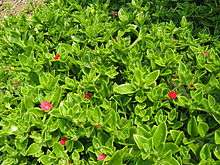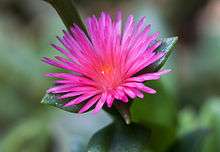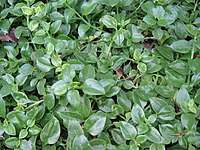Aptenia cordifolia
| Aptenia cordifolia | |
|---|---|
 | |
| Scientific classification | |
| Kingdom: | Plantae |
| (unranked): | Angiosperms |
| (unranked): | Eudicots |
| (unranked): | Core eudicots |
| Order: | Caryophyllales |
| Family: | Aizoaceae |
| Genus: | Aptenia |
| Species: | A. cordifolia |
| Binomial name | |
| Aptenia cordifolia | |
| Synonyms | |
|
Baby sun rose | |
Aptenia cordifolia is a species of succulent plant in the iceplant family known by the common names heartleaf iceplant[3] and baby sun rose. The specific epithet is derived from the Latin word cor for heart (because of the heart-shaped leaves). A creeping plant that forms a carpet of flat-growing perennial herbs in groups on the ground from a base, it is sometimes referred to as the heart-leaved aptenia or heart-leaved midday flower because, like many other representatives of the Aizoaceae, it opens its flowers only during the sunshine of the day.[4]
Taxonomy
Perhaps the most common plant seen under this name in gardens is actually Aptenia 'Red Apple', a hybrid with red flowers and bright green leaves, whose parents are A. cordifolia and A. (Platythyra) haeckeliana. The true species of A. cordifolia has magenta-purple flowers and more heart-shaped, mid-green, textured leaves.[5]
Hybrid
The hybrid, A. "Red Apple", has, in some areas, escaped cultivation and now grows as an introduced species, and is often confused with the true Aptenia cordifolia. It is a hybrid between Aptenia cordifolia and Aptenia haeckeliana, with more vigorous growth, and an ability to root from small bits of stem making it a poor choice for planting adjacent to wild lands. Its flowers tend to have a more reddish color (unlike the authentic A. cordifolia in which they are magenta-purple) and leaves which are less heart-shaped and brighter green in color.[6]
Habitat
Native to southern Africa, this species has become widely known as an ornamental plant. Today, however, it can be found in many warmer, mainly coastal areas planted or wild (including the Mediterranean region, the Canary Islands, California and Australia). The frost-intolerant plant needs a sunny spot and well drained soil.[7]
Description
This is a mat-forming perennial herb growing in flat clumps on the ground from a woody base. Stems reach up to about 60 centimetres (24 in) long. Bright pink to purplish flowers appear in the leaf axils and are open during the day. The stems are green and stalk-round. The fleshy, small leaves are opposite, ovate to cordate, about 2.5 centimetres (0.98 in) long and covered with fine papillae. These colored whorls are not petals, but non-functional stamens. The fruit is a capsule of little more than one centimeter in length with millimeter brown tuberose seeds. There is a variegated form.[8]
Propagation
It easily reproduces from cuttings of the developed stems, roots, seeds of its capsular fruit, and even from its own buried leaves. Seeds must be sowed in summer and cuttings can be done in early spring in cooler climates. For cuttings, the plant can be divided and runners can be planted directly into the ground. The garden bed must be readied by digging over the soil. Compost and a slow-release fertilizer may be added to ensure healthy growth. With regard to risks, it is very resistant to drought, but with moist soil it grows rapidly. It is convenient that the farmland has good drainage. It cannot withstand frost, where it freezes below −5 °C (23 °F).
Cultivation
Aptenia cordifolia can be planted as a fast-growing, not hardy, groundcover in flower boxes and around traffic lights. This plant is also ideal for covering walls, rockeries and bare areas of grass. Due to its extensive development, it is useful to prevent the growth of weeds in the field where it is planted. It can also survive without problems in a pot, where it is grown in hanging baskets so the long trailing branches can hang down with their leaves spaced out. The hibernation takes place either in a frost-free, sunny place at approximately 5 to 8 °C (41 to 46 °F). In addition to the species, one also encounters the variety A. cordifolia 'Variegata', whose leaves have creamy white edges and rarely on a white-flowering form.
The plant is also used in the kitchen, mostly for decorative purposes or mixed with salad. The fleshy leaves have a sour taste. In addition, the locals of the region of origin use the plant for its anti-inflammatory properties.[9]
Gallery
 Flower
Flower- Climbing
 On ground
On ground
References
- ↑ "Aptenia Cordifolia – Plantbook".
- ↑ Lucas, Norma (January 2009). "Aptenia Cordifolia – Plantz Africa".
- ↑ "Aptenia cordifolia". Natural Resources Conservation Service PLANTS Database. USDA. Retrieved 8 January 2016.
- ↑ C. Brickell (ed.): Encyclopedia of garden and indoor plants. Orbis, Munich 1994, ISBN 3-572-00685-6
- ↑ Flora of North America Editorial Committee, e. 2003. Magnoliophyta: Caryophyllidae, part 1. 4: i-xxiv, 1-559. In Fl. N. Amer. Oxford University Press , New York
- ↑ Wunderlin, RP 1998. Guide Vasc. Pl. Florida i-x + 1-806. University Press of Florida, Gainseville
- ↑ Prescott, A. & J. Venning. 1984. Aizoaceae. Flora of Australia 19-62
- ↑ W. Haage: Cacti and succulents. Quelle & Meyer, Heidelberg 1989, ISBN 3-494-01143-5
- ↑ J. Ettelt: succulent card index. In: cacti and other succulents. 3/2004.
External links
| Wikispecies has information related to Aptenia cordifolia |
| Wikimedia Commons has media related to Aptenia cordifolia. |